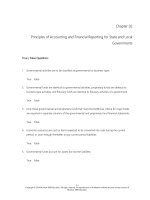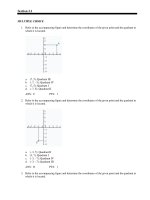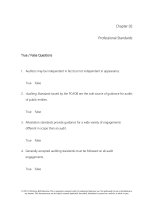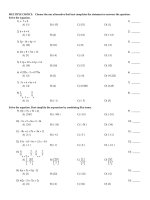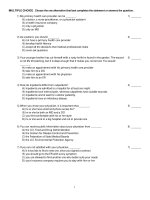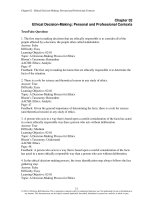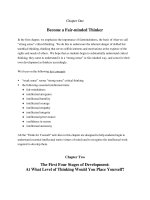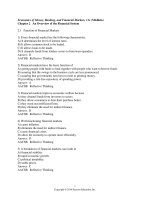Handbook of informatics for nurses and healthcare professionals 5th edition hebda test bank
Bạn đang xem bản rút gọn của tài liệu. Xem và tải ngay bản đầy đủ của tài liệu tại đây (310.71 KB, 22 trang )
Hebda, Handbook of Informatics, 5/e Test Bank
Chapter 2
Question 1
Type: MCSA
Which statement concerning "thin client technology" is correct?
1. System processing occurs on both the server and on the local PC.
2. A thin client consists of a display with keyboard and requires its own storage device.
3. Software exists on the server, therefore upgrades are done in one step for all clients.
4. When implemented, older PCs formerly used in networking must be replaced.
Correct Answer: 3
Rationale 1: All system processing occurs on the server, rather than on the thin client or local PC, as seen in
traditional client/server technology. When using thin client technology, software resides on the server requiring
only one upgrade on the server rather than a physical visit to each PC or client. Security is also enhanced because
users cannot locally run foreign disks/memory sticks that may contain a virus.
Rationale 2: A thin client is primarily a display, keyboard, and mouse or other pointing device and does not
require local drives or storage devices. When using thin client technology, software resides on the server requiring
only one upgrade on the server rather than a physical visit to each PC or client. Security is also enhanced because
users cannot locally run foreign disks/memory sticks that may contain a virus.
Rationale 3: When using thin client technology, software resides on the server requiring only one upgrade on the
server rather than a physical visit to each PC or client. Security is also enhanced because users cannot locally run
foreign disks/memory sticks that may contain a virus.
Rationale 4: Any PC can serve as a thin client. System processing occurs on the server; therefore, older
equipment may be utilized as a client with the addition of a pointing device. When using thin client technology,
software resides on the server requiring only one upgrade on the server rather than a physical visit to each PC or
client. Security is also enhanced because users cannot locally run foreign disks/memory sticks that may contain a
virus.
Global Rationale:
Cognitive Level: Applying
Client Need: Safe Effective Care Environment
Client Need Sub: Management of Care
Nursing/Integrated Concepts: Teaching and Learning
Learning Outcome:
Hebda, Handbook of Informatics, 5/e Test Bank
Copyright 2012 by Pearson Education, Inc.
Question 2
Type: MCSA
Which health risk related to computer use has been best documented?
1. Miscarriage or sterility
2. Ulnar nerve syndrome
3. Carpal tunnel syndrome
4. Cataracts
Correct Answer: 3
Rationale 1: Research has not established any clear links between computer use and miscarriage or sterility.
Carpal tunnel syndrome, a repetitive-stress injury, has been researched and documented as occurring with
computer use.
Rationale 2: Research has not established any clear links between computer use and ulnar nerve syndrome.
Carpal tunnel syndrome, a repetitive-stress injury, has been researched and documented as occurring with
computer use.
Rationale 3: Correct. Carpal tunnel syndrome, a repetitive-stress injury, has been researched and documented as
occurring with computer use.
Rationale 4: Research has not established any clear links between computer use and cataracts. Carpal tunnel
syndrome, a repetitive-stress injury, has been researched and documented as occurring with computer use.
Global Rationale:
Cognitive Level: Applying
Client Need: Safe Effective Care Environment
Client Need Sub: Management of Care
Nursing/Integrated Concepts: Communication and Documentation
Learning Outcome:
Question 3
Type: MCSA
Health care information plans include adding super users to the hospital staff. Which person is most appropriate
for this role?
1. An experienced staff nurse who has been employed at the institution for three years
2. An informatics nurse specialist with a master's degree and informatics certification
Hebda, Handbook of Informatics, 5/e Test Bank
Copyright 2012 by Pearson Education, Inc.
3. A newly hired charge nurse who has practiced for ten years in an intensive care unit
4. A clinical nurse specialist for three departments, employed at the institution for six years
Correct Answer: 1
Rationale 1: Correct. An experienced staff nurse who has clinical experience in the institution would be very
useful as a resource person.
Rationale 2: An informatics nurse specialist with a master's degree and certification in informatics would not
know the clinical area well enough or be able to answer questions from users about the hospital. An experienced
staff nurse who has clinical experience in the institution would be very useful as a resource person.
Rationale 3: A newly hired charge nurse who has practiced for ten years in an intensive care unit would not know
the clinical area well enough or be able to answer questions from users about the hospital computer system. An
experienced staff nurse who has clinical experience in the institution would be very useful as a resource person.
Rationale 4: The clinical nurse specialist for three departments who has been employed at the institution for six
years would not know the clinical area well enough or be able to answer questions from users about the hospital.
Global Rationale:
Cognitive Level: Applying
Client Need: Safe Effective Care Environment
Client Need Sub: Management of Care
Nursing/Integrated Concepts: Teaching and Learning
Learning Outcome:
Question 4
Type: MCSA
Which example best fits the description of a local area network (LAN)?
1. One server communicates with multiple PCs and printers
2. Office computers are connected through the use of the Internet
3. Client computers are interconnected with multiple servers
4. Internet technology is used to communicate with hospital suppliers
Correct Answer: 1
Rationale 1: A local area network connects multiple PCs and printers to create a shared system.
Rationale 2: The Internet actually consists of thousands of interconnected networks. A LAN is confined to a
single building or campus and has only one server.
Hebda, Handbook of Informatics, 5/e Test Bank
Copyright 2012 by Pearson Education, Inc.
Rationale 3: Networks with multiple servers are known as wide area networks (WANs). A LAN has only one
server.
Rationale 4: The Internet actually consists of thousands of interconnected networks. A LAN is confined to a
single building or campus and has only one server.
Global Rationale:
Cognitive Level: Understanding
Client Need: Safe Effective Care Environment
Client Need Sub: Management of Care
Nursing/Integrated Concepts: Communication and Documentation
Learning Outcome:
Question 5
Type: MCSA
In which instance is using a wireless device an advantage for health care provider staff?
1. More memory is needed to input data for glucose monitoring and insulin coverage.
2. Error reduction is needed to input data, such as vital signs from a client's isolation room.
3. A larger screen is needed to track data, such as medication administration times with vital signs.
4. An increase in security is needed to prevent physician orders from being intercepted on the Intranet.
Correct Answer: 2
Rationale 1: A wireless device is an advantage for a client's isolation room. Wireless technology may be used at
the bedside to facilitate data entry at the point-of-care. However, disadvantages of wireless devices include the
potential for data interception, less available memory, and smaller screens.
Rationale 2: Correct. A wireless device is an advantage for a client's isolation room. Wireless technology may be
used at the bedside to facilitate data entry at the point-of-care. However, disadvantages of wireless devices include
the potential for data interception, less available memory, and smaller screens.
Rationale 3: A wireless device is an advantage for a client's isolation room. Wireless technology may be used at
the bedside to facilitate data entry at the point-of-care. However, disadvantages of wireless devices include the
potential for data interception, less available memory, and smaller screens.
Rationale 4: A wireless device is an advantage for a client's isolation room. Wireless technology may be used at
the bedside to facilitate data entry at the point-of-care. However, disadvantages of wireless devices include the
potential for data interception, less available memory, and smaller screens.
Global Rationale:
Hebda, Handbook of Informatics, 5/e Test Bank
Copyright 2012 by Pearson Education, Inc.
Cognitive Level: Applying
Client Need: Safe Effective Care Environment
Client Need Sub: Management of Care
Nursing/Integrated Concepts: Communication and Documentation
Learning Outcome:
Question 6
Type: MCSA
Which of these is the most flexible and reliable secondary storage device?
1. DVD drive
2. Magnetic tape drive
3. CD-ROM drive
4. Zip drive
Correct Answer: 1
Rationale 1: Correct. The most flexible and reliable secondary storage device is DVD drives; they can read CD
disks as well. Zip drives are used to store and transfer data but storage is limited. Magnetic tape drives store data
and can be used to back up or transfer data.
Rationale 2: The most flexible and reliable secondary storage device is DVD drives; they can read CD disks as
well. Zip drives are used to store and transfer data but storage is limited. Magnetic tape drives store data and can
be used to back up or transfer data.
Rationale 3: The most flexible and reliable secondary storage device is DVD drives; they can read CD disks as
well. Zip drives are used to store and transfer data but storage is limited. Magnetic tape drives store data and can
be used to back up or transfer data.
Rationale 4: The most flexible and reliable secondary storage device is DVD drives; they can read CD disks as
well. Zip drives are used to store and transfer data but storage is limited. Magnetic tape drives store data and can
be used to back up or transfer data.
Global Rationale:
Cognitive Level: Analyzing
Client Need: Safe Effective Care Environment
Client Need Sub: Management of Care
Nursing/Integrated Concepts: Communication and Documentation
Learning Outcome:
Question 7
Hebda, Handbook of Informatics, 5/e Test Bank
Copyright 2012 by Pearson Education, Inc.
Type: MCSA
Which of these is an advantage in the use of personal digital assistants (PDAs) in the health care setting?
1. PDAs may be synchronized with any network without the use of special equipment or software.
2. PDAs minimize the chance of interception of data transmission.
3. Current medication information may be easily stored and compared to actual client data.
4. Data loss is minimized due to long battery life and ease of backups.
Correct Answer: 3
Rationale 1: An advantage in the use of PDAs is that current medication information may be easily stored and
compared to actual client data. Synchrony with other computers may require special equipment. Information may
still be intercepted, and battery life varies greatly.
Rationale 2: An advantage in the use of PDAs is that current medication information may be easily stored and
compared to actual client data. Even though a PDA only transmits data over short distances, synchrony with other
computers may require special equipment. Information may still be intercepted, and battery life varies greatly.
Rationale 3: Correct. An advantage in the use of PDAs is that current medication information may be easily
stored and compared to actual client data. Synchrony with other computers may require special equipment.
Information may still be intercepted, and battery life varies greatly.
Rationale 4: An advantage in the use of PDAs is that current medication information may be easily stored and
compared to actual client data. Synchrony with other computers may require special equipment. Information may
still be intercepted, and battery life varies greatly.
Global Rationale:
Cognitive Level: Analyzing
Client Need: Safe Effective Care Environment
Client Need Sub: Management of Care
Nursing/Integrated Concepts: Communication and Documentation
Learning Outcome:
Question 8
Type: MCSA
Research best supports the use of which ergonomic device?
1. Ergonomic mouse to reduce wrist and hand pain
2. Support brace used while typing to prevent carpal tunnel syndrome
Hebda, Handbook of Informatics, 5/e Test Bank
Copyright 2012 by Pearson Education, Inc.
3. Lumbar back support to maintain natural curves of the back
4. Wrist rests to support the wrists while inputting data and typing
Correct Answer: 3
Rationale 1: Only the lumbar back support has been documented to reduce strain and minimize back pain. The
others have not consistently tested as helpful.
Rationale 2: Only the lumbar back support has been documented to reduce strain and minimize back pain. The
others have not consistently tested as helpful.
Rationale 3: Correct. Only the lumbar back support has been documented to reduce strain and minimize back
pain. The others have not consistently tested as helpful.
Rationale 4: Only the lumbar back support has been documented to reduce strain and minimize back pain. The
others have not consistently tested as helpful.
Global Rationale:
Cognitive Level: Analyzing
Client Need: Safe Effective Care Environment
Client Need Sub: Management of Care
Nursing/Integrated Concepts: Nursing Process: Assessment
Learning Outcome:
Question 9
Type: MCSA
Many workstations house clinical information systems and provide Internet access in the acute care setting.
Which type of software program is most likely to be used by the health care staff providing direct patient care?
1. A programming language such as Java to access the Internet
2. A virus checker to increase security for Internet connections
3. A programming language such as COBOL to create databases
4. A programming language such as Visual Basic to enter data
Correct Answer: 2
Rationale 1: A virus checker to increase security for Internet connections is the most likely to be used by health
care staff providing direct patient care. Utility programs may be used to increase security and prevent data from
falling into the wrong hands. Programming languages such as Visual Basic, COBOL, or Java are used in specialty
applications.
(Reference: textbook Table 2-2 Examples of Ergonomic Devices.)
Hebda, Handbook of Informatics, 5/e Test Bank
Copyright 2012 by Pearson Education, Inc.
Rationale 2: Correct. A virus checker to increase security for Internet connections is the most likely to be used by
health care staff providing direct patient care. Utility programs may be used to increase security and prevent data
from falling into the wrong hands. Programming languages such as Visual Basic, COBOL, or Java are used in
specialty applications.
(Reference: textbook Table 2-2 Examples of Ergonomic Devices.)
Rationale 3: A virus checker to increase security for Internet connections is the most likely to be used by health
care staff providing direct patient care. Utility programs may be used to increase security and prevent data from
falling into the wrong hands. Programming languages such as Visual Basic, COBOL, or Java are used in specialty
applications.
(Reference: textbook Table 2-2 Examples of Ergonomic Devices.)
Rationale 4: A virus checker to increase security for Internet connections is the most likely to be used by health
care staff providing direct patient care. Utility programs may be used to increase security and prevent data from
falling into the wrong hands. Programming languages such as Visual Basic, COBOL, or Java are used in specialty
applications.
(Reference: textbook Table 2-2 Examples of Ergonomic Devices.)
Global Rationale:
Cognitive Level: Applying
Client Need: Safe Effective Care Environment
Client Need Sub: Management of Care
Nursing/Integrated Concepts: Communication and Documentation
Learning Outcome:
Question 10
Type: FIB
______________________________ is the science and technology of engineering devices at the molecular level.
Standard Text:
Correct Answer: Nanotechnology
Rationale : Nanotechnology is the science and technology of engineering devices at the molecular level.
Global Rationale:
Cognitive Level: Understanding
Client Need: Safe Effective Care Environment
Client Need Sub: Management of Care
Nursing/Integrated Concepts: Communication and Documentation
Learning Outcome:
Question 11
Hebda, Handbook of Informatics, 5/e Test Bank
Copyright 2012 by Pearson Education, Inc.
Type: MCSA
Which statement best describes the role of the chief privacy officer (CPO)?
1. Duties include protection of the personal health information of patients, both electronic and paper
2. Duties include strategic planning, information security, and overall management of the information system
3. Duties include assigning and monitoring system access identification codes and passwords
4. Duties include design, maintenance, and security of materials placed on the Internet, intranet, and extranet
Correct Answer: 1
Rationale 1: Correct. A CPO is mandated by federal legislation to protect personal health information of patients;
this includes both paper and electronic information. CPO duties include strategic planning, information security,
and overall management of the information system. A webmaster is responsible for the design, maintenance, and
security of materials placed on the Internet. The security officer's duties include assigning and monitoring system
access identification codes and passwords.
Rationale 2: A CPO is mandated by federal legislation to protect personal health information of patients; this
includes both paper and electronic information. CPO duties include strategic planning, information security, and
overall management of the information system. A webmaster is responsible for the design, maintenance, and
security of materials placed on the Internet. The security officer's duties include assigning and monitoring system
access identification codes and passwords.
Rationale 3: A CPO is mandated by federal legislation to protect personal health information of patients; this
includes both paper and electronic information. CPO duties include strategic planning, information security, and
overall management of the information system. A webmaster is responsible for the design, maintenance, and
security of materials placed on the Internet. The security officer's duties include assigning and monitoring system
access identification codes and passwords.
Rationale 4: A CPO is mandated by federal legislation to protect personal health information of patients; this
includes both paper and electronic information. CPO duties include strategic planning, information security, and
overall management of the information system. A webmaster is responsible for the design, maintenance, and
security of materials placed on the Internet. The security officer's duties include assigning and monitoring system
access identification codes and passwords.
Global Rationale:
Cognitive Level: Understanding
Client Need: Safe Effective Care Environment
Client Need Sub: Management of Care
Nursing/Integrated Concepts: Teaching and Learning
Learning Outcome:
Question 12
Hebda, Handbook of Informatics, 5/e Test Bank
Copyright 2012 by Pearson Education, Inc.
Type: MCSA
What is the one byte binary code representation for the Arabic number 8?
1. 1000
2. 00001000
3. 2222
4. 11111111
Correct Answer: 2
Rationale 1: Binary code is a series of 1s and 0s called bits, and one byte contains 8 bits. The binary system is
positional with each position's value increasing by the power of 2.
The right most position value is 20 or 1 and continuing to the left the values would be 21 = 2, 22 = 4, 23 = 8 and so
on. The Arabic number represented is the sum of the powers of 2 represented by the 0s and 1s. The sum of the
powers of binary 00001000 is 0 + 0 + 0 + 0 + 8 + 0 + 0 + 0 = 8, so the correct choice for representing the Arabic
number 8 is the binary code 00001000. The binary code 1000 represents the Arabic number 8 but is not a byte.
(Reference: textbook Figure 2-3 [Internal view of a PC] will show some items that may be inside a computer
cabinet.)
Rationale 2: Binary code is a series of 1s and 0s called bits, and one byte contains 8 bits. The binary system is
positional with each position's value increasing by the power of 2.The right most position value is 20 or 1 and
continuing to the left the values would be 21 = 2, 22 = 4, 23 = 8 and so on. The Arabic number represented is the
sum of the powers of 2 represented by the 0s and 1s. The sum of the powers of binary 00001000 is 0 + 0 + 0 + 0 +
8 + 0 + 0 + 0 = 8, so the correct choice for representing the Arabic number 8 is the binary code 00001000.
(Reference: textbook Figure 2-3 [Internal view of a PC] will show some items that may be inside a computer
cabinet.)
Rationale 3: Binary code is a series of 1s and 0s called bits, and one byte contains 8 bits. The binary system is
positional with each position's value increasing by the power of 2.
The right most position value is 20 or 1 and continuing to the left the values would be 21 = 2, 22 = 4, 23 = 8 and so
on. The Arabic number represented is the sum of the powers of 2 represented by the 0s and 1s. The sum of the
powers of binary 00001000 is 0 + 0 + 0 + 0 + 8 + 0 + 0 + 0 = 8, so the correct choice for representing the Arabic
number 8 is the binary code 00001000. The numeral 2 is not used in writing binary code.
(Reference: textbook Figure 2-3 [Internal view of a PC] will show some items that may be inside a computer
cabinet.)
Rationale 4: Binary code is a series of 1s and 0s called bits, and one byte contains 8 bits. The binary system is
positional with each position's value increasing by the power of 2.
The right most position value is 20 or 1 and continuing to the left the values would be 21 = 2, 22 = 4, 23 = 8 and so
on. The Arabic number is the sum of the powers of 2 represented by the 0s and 1s. The sum of the powers of
binary 11111111 is 128 + 64 + 32 + 16 + 8 + 4 + 2 + 1 = 255. The sum of the powers of binary 00001000 is 0 + 0
+ 0 + 0 + 8 + 0 + 0 + 0 = 8, so the correct choice for representing the Arabic number 8 is the binary code
00001000.
Hebda, Handbook of Informatics, 5/e Test Bank
Copyright 2012 by Pearson Education, Inc.
(Reference: textbook Figure 2-3 [Internal view of a PC] will show some items that may be inside a computer
cabinet.)
Global Rationale:
Cognitive Level: Remembering
Client Need: Safe Effective Care Environment
Client Need Sub: Management of Care
Nursing/Integrated Concepts: Teaching and Learning
Learning Outcome:
Question 13
Type: FIB
________________________________ is defined as an electronic circuitry that executes computer instructions.
Standard Text:
Correct Answer: Central Processing Unit (CPU)
Rationale :
Central Processing Unit (CPU) is defined as electronic circuitry that executes computer instructions.
Global Rationale:
Cognitive Level: Understanding
Client Need: Safe Effective Care Environment
Client Need Sub: Management of Care
Nursing/Integrated Concepts: Teaching and Learning
Learning Outcome:
Question 14
Type: MCSA
Which of the following is not a common input device?
1. Network
2. Keyboard
3. Webcamera
4. Joystick
Correct Answer: 1
Hebda, Handbook of Informatics, 5/e Test Bank
Copyright 2012 by Pearson Education, Inc.
Rationale 1: Input devices allow the user to feed data into the computer. Common input devices include the
keyboard, mouse and trackball, touch sensitive screen, stylus, microphone, bar code reader, fax modem card,
joystick, image scanner, fingerprint scanner, digital camera, and webcam. A network is not an input device.
Rationale 2: Input devices allow the user to feed data into the computer. Common input devices include the
keyboard, mouse and trackball, touch sensitive screen, stylus, microphone, bar code reader, fax modem card,
joystick, image scanner, fingerprint scanner, digital camera, and webcam.
Rationale 3: Input devices allow the user to feed data into the computer. Common input devices include the
keyboard, mouse and trackball, touch sensitive screen, stylus, microphone, bar code reader, fax modem card,
joystick, image scanner, fingerprint scanner, digital camera, and webcam.
Rationale 4: Input devices allow the user to feed data into the computer. Common input devices include the
keyboard, mouse and trackball, touch sensitive screen, stylus, microphone, bar code reader, Fax modem card,
joystick, image scanner, fingerprint scanner, digital camera, and webcam.
Global Rationale:
Cognitive Level: Understanding
Client Need: Safe Effective Care Environment
Client Need Sub: Management of Care
Nursing/Integrated Concepts: Teaching and Learning
Learning Outcome:
Question 15
Type: MCSA
Which of the following best describes RAID technology?
1. The computer shuts down when a single disk fails.
2. Community clinics use a primary data storage drive.
3. RAID costs more than using one large disk drive.
4. Duplicate disks mirror copies of data.
Correct Answer: 4
Rationale 1: RAID is a secondary storage technology that uses duplicate disks to mirror copies of data. Using
RAID may be less costly than using one large disk drive. In the event that an individual disk fails, the remaining
RAID would permit the computer to continue working uninterrupted.
Rationale 2: RAID is secondary storage technology that uses duplicate disks to mirror copies of data. Using
RAID may be less costly than using one large disk drive. In the event that an individual disk fails, the remaining
RAID would permit the computer to continue working uninterrupted.
Hebda, Handbook of Informatics, 5/e Test Bank
Copyright 2012 by Pearson Education, Inc.
Rationale 3: RAID is a secondary storage technology that uses duplicate disks to mirror copies of data. Using
RAID may be less costly than using one large disk drive. In the event that an individual disk fails, the remaining
RAID would permit the computer to continue working uninterrupted.
Rationale 4: RAID is secondary storage technology that uses duplicate disks to mirror copies of data. Using
RAID may be less costly than using one large disk drive. In the event that an individual disk fails, the remaining
RAID would permit the computer to continue working uninterrupted.
Global Rationale:
Cognitive Level: Understanding
Client Need: Safe Effective Care Environment
Client Need Sub: Management of Care
Nursing/Integrated Concepts: Communication and Documentation
Learning Outcome:
Question 16
Type: MCSA
Which of the following best describes an intranet?
1. The largest and best known electronic network in the world
2. Limited to systems affiliated with education and government agencies
3. A network outside of the hospital system for use by customers or suppliers
4. A private hospital system that is protected from outside access
Correct Answer: 4
Rationale 1: Intranets are private company networks that are protected from outside access. A network outside of
the company system for use by customers or suppliers would be an extranet. The largest and best known network
in the world is the Internet. The Internet was once limited to individuals affiliated with educational institutions
and government agencies, but access is now available to the public.
Rationale 2: Intranets are private company networks that are protected from outside access. A network outside of
the company system for use by customers or suppliers would be an extranet. The largest and best known network
in the world is the Internet. The Internet was once limited to individuals affiliated with educational institutions
and government agencies, but access is now available to the public.
Rationale 3: Intranets are private company networks that are protected from outside access. A network outside of
the company system for use by customers or suppliers would be an extranet. The largest and best known network
in the world is the Internet. The Internet was once limited to individuals affiliated with educational institutions
and government agencies, but access is now available to the public.
Hebda, Handbook of Informatics, 5/e Test Bank
Copyright 2012 by Pearson Education, Inc.
Rationale 4: Intranets are private company networks that are protected from outside access. A network outside of
the company system for use by customers or suppliers would be an extranet. The largest and best known network
in the world is the Internet. The Internet was once limited to individuals affiliated with educational institutions
and government agencies, but access is now available to the public.
Global Rationale:
Cognitive Level: Analyzing
Client Need: Safe Effective Care Environment
Client Need Sub: Management of Care
Nursing/Integrated Concepts: Communication and Documentation
Learning Outcome:
Question 17
Type: MCSA
What are the two types of memory categories?
1. Control and central processing units
2. Read-only memory (ROM) and Random access memory (RAM)
3. Flash drives and user ports
4. CDROMs and DVDs
Correct Answer: 2
Rationale 1: Random access memory (RAM) is a temporary storage area that is active only while the computer is
turned on. It provides storage for the program that is running, as well as for the data that are being processed.
Read-only memory (ROM) is permanent; it remains when the power is off. It typically cannot be changed by the
user unless additional memory is installed. ROM contains start-up instructions that are executed each time the
computer is turned on.
Rationale 2: RAM is a temporary storage area that is active only while the computer is turned on. It provides
storage for the program that is running, as well as for the data that are being processed. ROM is permanent; it
remains when the power is off. It typically cannot be changed by the user unless additional memory is installed.
ROM contains start-up instructions that are executed each time the computer is turned on.
Rationale 3: Random access memory (RAM) is a temporary storage area that is active only while the computer is
turned on. It provides storage for the program that is running, as well as for the data that are being processed.
Read-only memory (ROM) is permanent; it remains when the power is off. It typically cannot be changed by the
user unless additional memory is installed. ROM contains start-up instructions that are executed each time the
computer is turned on.
Rationale 4: Random access memory (RAM) is a temporary storage area that is active only while the computer is
turned on. It provides storage for the program that is running, as well as for the data that are being processed.
Hebda, Handbook of Informatics, 5/e Test Bank
Copyright 2012 by Pearson Education, Inc.
Read-only memory (ROM) is permanent; it remains when the power is off. It typically cannot be changed by the
user unless additional memory is installed. ROM contains start-up instructions that are executed each time the
computer is turned on.
Global Rationale:
Cognitive Level: Understanding
Client Need: Safe Effective Care Environment
Client Need Sub: Management of Care
Nursing/Integrated Concepts: Teaching and Learning
Learning Outcome:
Question 18
Type: MCSA
Which of the following statements is correct about Blu-ray?
1. Blu-ray is a system that has replaced the optical scanner.
2. Blu-ray is a high density optical disc format; rival to HD-DVD.
3. Blu-ray functions are yet to be incorporated in health care systems.
4. Blu-ray has been designed to store data collected at the bedside.
Correct Answer: 2
Rationale 1: Blu-ray is a high-density optical disc format; rival to HD-DVD.
Rationale 2: Blu-ray is a high-density optical disc format; rival to HD-DVD.
Rationale 3: Blu-ray is a high-density optical disc format; rival to HD-DVD.
Rationale 4: Blu-ray is a high-density optical disc format; rival to HD-DVD.
Global Rationale:
Cognitive Level: Understanding
Client Need: Safe Effective Care Environment
Client Need Sub: Management of Care
Nursing/Integrated Concepts: Teaching and Learning
Learning Outcome:
Question 19
Type: MCSA
Hebda, Handbook of Informatics, 5/e Test Bank
Copyright 2012 by Pearson Education, Inc.
Which of the following statements is true about portable or laptop computers?
1. Portable or laptop computers are unnecessary at the bedside.
2. Portable or laptop computers can be connected to networks or peripheral devices through the use of a Personal
Computer Memory Card International Association (PCMCIA) card.
3. Portable or laptop computers have been replaced by smaller handheld devices.
4. Portable or laptop computers do not have enough memory to effectively store clinical data.
Correct Answer: 2
Rationale 1: Portable or laptop computers can be connected to networks or peripheral devices through the use of
a Personal Computer Memory Card International Association (PCMCIA) card. These cards can be inserted into a
slot in the case of the laptop computer.
Rationale 2: Portable or laptop computers can be connected to networks or peripheral devices through the use of
a Personal Computer Memory Card International Association (PCMCIA) card. These cards can be inserted into a
slot in the case of the laptop computer.
Rationale 3: Portable or laptop computers can be connected to networks or peripheral devices through the use of
a Personal Computer Memory Card International Association (PCMCIA) card. These cards can be inserted into a
slot in the case of the laptop computer.
Rationale 4: Portable or laptop computers can be connected to networks or peripheral devices through the use of
a Personal Computer Memory Card International Association (PCMCIA) card. These cards can be inserted into a
slot in the case of the laptop computer.
Global Rationale:
Cognitive Level: Applying
Client Need: Safe Effective Care Environment
Client Need Sub: Management of Care
Nursing/Integrated Concepts: Communication and Documentation
Learning Outcome:
Question 20
Type: MCSA
Which of the following responses is most accurate in describing "thin client" or "fat client"?
1. The "thin client" is primarily a display, keyboard, and mouse or other pointing device.
2. "Fat" client technology is also known as server-based computing.
3. "Fat" client technology represents networking model that relies on highly efficient servers.
Hebda, Handbook of Informatics, 5/e Test Bank
Copyright 2012 by Pearson Education, Inc.
4. "Thin" client technology used in traditional client/server networks has local drives or storage devices.
Correct Answer: 1
Rationale 1: The thin client is primarily a display, keyboard, and mouse or other pointing device. The minimal
hardware requirements for this model give rise to the name "thin client" as opposed to "fat client," as seen in
traditional client/server technology. PCs used in traditional client/server networks had local drives or storage
devices so they are referred to as fat clients.
Rationale 2: The thin client is primarily a display, keyboard, and mouse or other pointing device. The minimal
hardware requirements for this model give rise to the name "thin client" as opposed to "fat client," as seen in
traditional client/server technology. PCs used in traditional client/server networks had local drives or storage
devices so they are referred to as fat clients.
Rationale 3: The thin client is primarily a display, keyboard, and mouse or other pointing device. The minimal
hardware requirements for this model give rise to the name "thin client" as opposed to "fat client," as seen in
traditional client/server technology. PCs used in traditional client/server networks had local drives or storage
devices so they are referred to as fat clients.
Rationale 4: The thin client is primarily a display, keyboard, and mouse or other pointing device. The minimal
hardware requirements for this model give rise to the name "thin client" as opposed to "fat client," as seen in
traditional client/server technology. PCs used in traditional client/server networks had local drives or storage
devices so they are referred to as fat clients.
Global Rationale:
Cognitive Level: Understanding
Client Need: Safe Effective Care Environment
Client Need Sub: Management of Care
Nursing/Integrated Concepts: Teaching and Learning
Learning Outcome:
Question 21
Type: MCSA
Handheld or personal digital assistants (PDAs) are more visible in the health care system. Which of the following
answers best describes an advantage of using a PDA?
1. A PDA is easily transported to the point of care.
2. The probability of theft is high; therefore, nurses can keep the device in their pockets.
3. The PDA has a small screen size.
4. PDAs can hold up to rough use.
Correct Answer: 1
Hebda, Handbook of Informatics, 5/e Test Bank
Copyright 2012 by Pearson Education, Inc.
Rationale 1: A PDA is lightweight and portable and can be transported with ease to the bedside.
Rationale 2: Being concerned about theft is not an advantage of the PDA.
Rationale 3: A PDA with a small screen size is not an advantage and could limit the nurse's ability to read the
screen.
Rationale 4: PDAs are to be treated with care and cannot tolerate rough use.
Global Rationale:
Cognitive Level: Understanding
Client Need: Safe Effective Care Environment
Client Need Sub: Management of Care
Nursing/Integrated Concepts: Communication and Documentation
Learning Outcome:
Question 22
Type: FIB
A __________________________ is a combination of hardware and software that allows communication and
electronic transfer of information between computers.
Standard Text:
Correct Answer: network
Rationale : A network is a combination of hardware and software that allows communication and electronic
transfer of information between computers.
Global Rationale:
Cognitive Level: Understanding
Client Need: Safe Effective Care Environment
Client Need Sub: Management of Care
Nursing/Integrated Concepts: Communication and Documentation
Learning Outcome:
Question 23
Type: MCSA
Selecting a computer system depends primarily on the needs and expectations of the organization. Which of the
following choices are not relevant in the decision making process?
1. Applications needed to accomplish goals
Hebda, Handbook of Informatics, 5/e Test Bank
Copyright 2012 by Pearson Education, Inc.
2. Back up options
3. Cost
4. The computer literacy of the nursing staff
Correct Answer: 4
Rationale 1: Decision makers are called to identify the needs of the organization before selecting a computer
system. The system is then tailored to the organizational goals.
Rationale 2: When selecting a computer system, the back up of files and documents are placed on the agenda and
examined for relevance. In health care settings, it is essential to have a mechanism to back up all generated files.
Rationale 3: The cost of computer systems can rise to millions of dollars depending on the needs and size of the
institution. Therefore, cost and its impact on the budget are important considerations when choosing a system.
Rationale 4: The computer literacy of the nursing staff is not an essential component when selecting a network or
computer system for a health care setting. Nurses can be trained to use the hardware and software through a series
of continuing education or staff development programs.
Global Rationale:
Cognitive Level: Applying
Client Need: Safe Effective Care Environment
Client Need Sub: Management of Care
Nursing/Integrated Concepts: Teaching and Learning
Learning Outcome:
Question 24
Type: MCSA
A set of instructions that communicates with the computer and tells it what to do is called which of the following?
1. Software
2. Manual
3. Hardware
4. Input devices
Correct Answer: 1
Rationale 1: Software is a set of instructions that tells the computer what to do. Software is available in the forms
of programs and applications.
Hebda, Handbook of Informatics, 5/e Test Bank
Copyright 2012 by Pearson Education, Inc.
Rationale 2: A paper manual can be used as a teaching tool for the user. A manual does not directly communicate
with the computer.
Rationale 3: Computer hardware is the physical part of the computer and its associated equipment. Computer
hardware consists of many different parts, but the main elements are input devices, the central processing unit,
primary and secondary storage devices, and output devices. These devices may be contained within one shell or
may be separate but connected via cables or infrared technology.
Rationale 4: Input devices allow the user to feed data into the computer. Common input devices include the
keyboard, mouse and trackball, touch sensitive screen, stylus, microphone, bar code reader, fax modem card,
joystick, image scanner, fingerprint scanner, digital camera, and webcam.
Global Rationale:
Cognitive Level: Remembering
Client Need: Safe Effective Care Environment
Client Need Sub: Management of Care
Nursing/Integrated Concepts: Communication and Documentation
Learning Outcome:
Question 25
Type: MCSA
The primary disadvantage to client/server technology is which of the following?
1. Cost
2. Vulnerability
3. Computer education
4. Staff resistance to change
Correct Answer: 2
Rationale 1: Cost is a factor when selecting a system and, therefore, is not a disadvantage.
Rationale 2: Vulnerability arises with an increase in the number of users on any network system. More users
increase in the opportunities to compromise data.
Rationale 3: Educating the staff to use the computer with confidence is not considered a disadvantage to
client/server technology.
Rationale 4: Staff resistance can be overcome by incorporating their input in the design and needs of the system.
Resistance itself can be a useful tool when defining the needs of the organization as naysayers may pose ideas not
considered by the selection team.
Hebda, Handbook of Informatics, 5/e Test Bank
Copyright 2012 by Pearson Education, Inc.
Global Rationale:
Cognitive Level: Understanding
Client Need: Safe Effective Care Environment
Client Need Sub: Management of Care
Nursing/Integrated Concepts: Teaching and Learning
Learning Outcome:
Question 26
Type: MCSA
Which of the following terms serves as a set of programs designed to accomplish a particular task such as word
processing, financial management, or drawing?
1. Application software
2. Vista
3. XP
4. Windows
Correct Answer: 1
Rationale 1: Application software that includes word processing, presentation graphics, spreadsheets, databases,
and desktop publishing is considered software.
Rationale 2: Application software that includes word processing, presentation graphics, spreadsheets, databases,
and desktop publishing is considered software.
Rationale 3: Application software that includes word processing, presentation graphics, spreadsheets, databases,
and desktop publishing is considered software.
Rationale 4: Application software that includes word processing, presentation graphics, spreadsheets, databases,
and desktop publishing is considered software.
Global Rationale:
Cognitive Level: Understanding
Client Need: Safe Effective Care Environment
Client Need Sub: Management of Care
Nursing/Integrated Concepts: Teaching and Learning
Learning Outcome:
Question 27
Type: MCMA
Hebda, Handbook of Informatics, 5/e Test Bank
Copyright 2012 by Pearson Education, Inc.
Equipment and hardware selection are based on personal and institutional needs. Which of the following answers
are considered when selecting a system?
Standard Text: Select all that apply.
1. Program execution time
2. Number of workers needed to access computer at one time.
3. Storage capacity
4. Backup options
5. Budget constraints
Correct Answer: 1,2,3,4,5
Rationale 1: •Maintenance considerations. There are several issues related to maintenance. These include
durability, battery life and time required for recharging batteries, and the ability to easily disinfect or clean
equipment to minimize the chances of spreading infection (Neely & Sittig, 2002).
Rationale 2: •Maintenance considerations. There are several issues related to maintenance. These include
durability, battery life and time required for recharging batteries, and the ability to easily disinfect or clean
equipment to minimize the chances of spreading infection (Neely & Sittig, 2002).
Rationale 3: •Maintenance considerations. There are several issues related to maintenance. These include
durability, battery life and time required for recharging batteries, and the ability to easily disinfect or clean
equipment to minimize the chances of spreading infection (Neely & Sittig, 2002).
Rationale 4: •Maintenance considerations. There are several issues related to maintenance. These include
durability, battery life and time required for recharging batteries, and the ability to easily disinfect or clean
equipment to minimize the chances of spreading infection (Neely & Sittig, 2002).
Rationale 5: •Maintenance considerations. There are several issues related to maintenance. These include
durability, battery life and time required for recharging batteries, and the ability to easily disinfect or clean
equipment to minimize the chances of spreading infection (Neely & Sittig, 2002).
Global Rationale:
Cognitive Level: Understanding
Client Need: Safe Effective Care Environment
Client Need Sub: Management of Care
Nursing/Integrated Concepts: Nursing Process: Planning
Learning Outcome:
Hebda, Handbook of Informatics, 5/e Test Bank
Copyright 2012 by Pearson Education, Inc.

